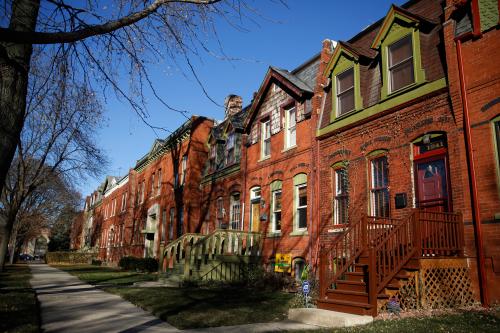Boarding homes, building codes, and neighborhood character: What “Little Women” can teach us about housing policy
Of the nine films competing for the top honor at this Sunday’s Academy Awards, there’s a few that take on issues of housing and urban policy, from the class conflicts of “Parasite” to the metropolitan decay in “Joker.” But it may just be the meticulous recreation of 19th century New England in Greta Gerwig’s “Little Women” that has the most to say about American homes, even offering some bold yet sensible lessons to improve our own 21st century housing policy.
Lesson 1: Middle-class homes do not drag down property values of nearby mansions.
A primary goal of modern zoning codes is to maintain homogeneous residential neighborhoods: New homes must be the same size, architectural style, and price as their neighbors. That also implies that the residents of those homes will be similarly affluent (and, by extension, of the same race). Show up to any public meeting where a developer proposes building smaller, less expensive homes and you will hear a legion of homeowners decry it as an assault on “neighborhood character”—not to mention diminishing their own property values.
If 19th century Concord, Mass. had such limitations on a neighborhood’s home sizes, the main characters in “Little Women” might never have found true love. A major plotline of the story— the budding romance(s) between the March family and Laurie Laurence—depends on the adjacency of their homes, despite clear differences in their economic and social status.
The four title characters—Meg, Jo, Beth, and Amy March—are sisters belonging to an educated but not affluent family. Their home reflects both their relatively modest economic circumstances and their ascetic, anti-materialist values: a detached single-family house with two-and-a-half stories, wooden construction, and a plain, dark brown exterior with little decorative trim. (The house from the film bears a striking resemblance to the Orchard House—see Figure 1—where author Louisa May Alcott originally wrote Little Women.)
Figure 1: No architectural frills for the March family
Orchard House in Concord, Mass., where Louisa May Alcott wrote Little Women
 Photo courtesy of Shutterstock
Photo courtesy of Shutterstock
Early in the story, the sisters become friends with their nearest neighbors, the elderly Mr. Laurence and his teenage grandson, who live in a luxurious mansion within sight of the March home. Described in the book as “the Palace Beautiful,” the movie version is shown as a long, white building with a columned portico and expansive windows, standing in stark contrast to the March family’s plain box. But despite the economic gap between the two families, their physical proximity allows them to interact daily and become close friends.
In the present day, Concord’s zoning requires most homes to be built on 40,000- to 80,000-square-foot lots, with front yards at least 40 feet deep—clear barriers to casual neighborly interactions.
Lesson 2: Waiving quality standards allows low-income families to live in expensive communities.
Houses today must meet minimum quality standards, detailed in building codes: requirements such as weather-resistant exterior walls, adequate indoor heating systems, and a specified number of plumbing fixtures based on building size. While building codes are intended to protect the health and safety of residents, they also raise the cost of constructing new housing.
The house occupied by the March family’s impoverished neighbors, the Hummels, does not appear to satisfy minimum quality standards. It’s a clearly self-built wooden cabin, with visible gaps between boards that let in cold air, and all eight family members live in a single room. Even by the standards of the late 19th century, amenities are primitive: There is no separate kitchen, no running water, and only a single fireplace for heat and cooking.
With that, it is highly doubtful that the Hummel family complied with a special permit process before constructing their home in a non-residentially zoned forest area, or completed an environmental impact review. Today, these sorts of standards—even if well-intentioned—effectively bar poor families from living in high-opportunity communities.
Lesson 3: Bring back the urban boarding house!
When Jo March decides to follow her literary ambitions to New York City, she lives where most urban singletons of the 19th century did: a boarding house. Before the widespread adoption of apartment buildings, boarding houses provided a substantial portion of urban housing. They were often owned and operated by widows who had been left with a large house but little income after the death of a husband. While boarding houses are now prohibited by zoning in most U.S. cities, back then they were very attractive to recent arrivals like Jo.
First—and most importantly—boarding houses were inexpensive. Boarders paid fees for a private bedroom, with access to some shared common space (parlor, bathroom) rather than a fully equipped apartment. Meals were cooked by the owner and served in a communal dining room. Jo most likely paid lower accommodation costs than other tenants because she provided help to the landlady, Mrs. Kirke.
Second, because of the communal aspects, boarding houses offered some introductory social life to newly arrived migrants. In the book, Jo’s letters home describe her new acquaintances in the house: Mrs. Kirke and her children; Miss Norton, “a rich, cultivated and kind” spinster who invites Jo to parties, lectures and concerts; and, of course, the jovial and learned Professor Bhaer, who’s come to New York to take custody of his orphaned nephews. (Spoiler alert: the social life of the boarding house was so fruitful that Jo and Professor Bhaer become more than friends by the end.)
Third, boarding houses were virtually the only option for single women “of marriageable age.” Until the late 19th century, women had limited legal rights to own or rent out real estate. Readers of Edith Wharton will recall that well-bred heroines such as Lily Bart had few independent living options because of the social prejudice attached to women living alone.
The concept behind boarding houses—that not all people want or can afford to occupy a private home complete with kitchen, bath, and separate living quarters—is making something of a comeback under the new brand of “co-living.” But these new purpose-built facilities are substantially more expensive than their progenitors.
Less zoning equals more social equity—and more romance
While some details of the world depicted in “Little Women” would not appeal to modern audiences—corsets and the lack of modern health care come to mind—a more laissez-faire approach to housing regulation seems worth revisiting. Can we imagine a return to communities where mansions, middle-class homes, boarding houses, and low-income housing can co-exist without legal restrictions or social prejudice? Where households with diverse incomes and family structures can interact with casual, everyday intimacy?
The prospect of a more equitable and socially connected world is evoked in the closing words of Marmee, the March family matriarch: “However long you may live, I never can wish you a greater happiness than this!”
Sarah Crump contributed excellent research for this post.
Cover photo courtesy of Roatti/Wikipedia (Creative Commons Attribution-ShareAlike 3.0 License).
The Brookings Institution is committed to quality, independence, and impact.
We are supported by a diverse array of funders. In line with our values and policies, each Brookings publication represents the sole views of its author(s).







Commentary
Three lessons 21st century housing policy could learn from “Little Women”
February 5, 2020